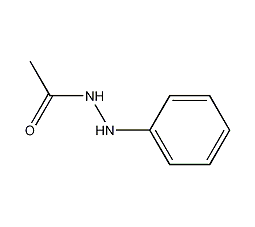
Structural formula
| Business number | 037F |
|---|---|
| Molecular formula | C8H10N2O |
| Molecular weight | 150.18 |
| label |
N-acetylphenylhydrazine, N-acetyl-N-phenylhydrazine, 1-acetyl-2-phenylhydrazine, Acetylphenylhydrazine, 1-acetyl-2-phenylhydrazine, Acetylphenylhydrazine, 1-Acetyl-2-phenylhydrazine, Hydracetin, Pyrodin, β-Acetyl phenylhydrazine, stabilizer |
Numbering system
CAS number:114-83-0
MDL number:MFCD00008672
EINECS number:204-055-3
RTECS number:AJ2900000
BRN number:742880
PubChem number:24890888
Physical property data
1. Properties: Colorless needle-like crystals. Odorless.
2. Density (g/mL, 25/4℃): Undetermined
3. Relative vapor density (g/mL, air=1): Undetermined
4. Melting point (ºC): 128-132
5. Boiling point (ºC, normal pressure): Undetermined
6. Boiling point (ºC, 5.2kPa): Undetermined
7. Refractive index: Undetermined
8. Flash point (ºC): Undetermined
9. Specific rotation (º): Undetermined Determined
10. Autoignition point or ignition temperature (ºC): Not determined
11. Vapor pressure (kPa, 25ºC): Not determined
12. Saturated vapor pressure (kPa, 60ºC): Undetermined
13. Heat of combustion (KJ/mol): Undetermined
14. Critical temperature (ºC): Undetermined
15. Critical pressure (KPa): Undetermined
16. Log value of oil-water (octanol/water) partition coefficient: Undetermined
17. Explosion upper limit ( %, V/V): Undetermined
18. Lower explosion limit (%, V/V): Undetermined
19. Solubility: Soluble in hot water and ethanol, difficult to Soluble in ether and cold water.
Toxicological data
1. Acute toxicity: Oral LD5O in mice: 270mg/kg
Intraperitoneal LDLO in mice: 150mg/kg
2. Other multiple dose toxicity: Rats Oral TDLO: 105mg/kg/7D-I
Oral TDLO: 112mg/kg/4W-I
bsp; Dog oral TDLO: 28mg/kg/7D-I
3. Tumor-causing: Mouse oral TDLO: 31g/kg/79W-I
4. Mutagenicity : Salmonella mutation: 333ug/plate
Ecological data
Slightly hazardous to water.
Molecular structure data
1. Molar refractive index: 44.11
2. Molar volume (cm3/mol): 131.3
3. Isotonic specific volume (90.2K ): 338.9
4. Surface tension (dyne/cm): 44.3
5. Polarizability (10-24cm3): 17.49
Compute chemical data
1. Reference value for hydrophobic parameter calculation (XlogP): None
2. Number of hydrogen bond donors: 2
3. Number of hydrogen bond acceptors: 2
4. Number of rotatable chemical bonds: 2
5. Number of tautomers: 2
6. Topological molecule polar surface area 41.1
7. Number of heavy atoms: 11
8. Surface charge: 0
9. Complexity: 130
10. Number of isotope atoms: 0
11. Determine the number of atomic stereocenters: 0
12. Uncertain number of atomic stereocenters: 0
13. Determine the number of chemical bond stereocenters: 0
14. Number of uncertain chemical bond stereocenters: 0
15. Number of covalent bond units: 1
Properties and stability
1. Toxic, avoid contact with oxides.
Storage method
1. Store in a cool, ventilated warehouse. Keep away from fire and heat sources. They should be stored separately from oxidants, etc. and avoid mixed storage. Equipped with corresponding varieties and quantities of
fire-fighting equipment. The storage area should be equipped with emergency release equipment and suitable containment materials.
Synthesis method
Reaction of phenylhydrazine and acetic acid. Heat phenylhydrazine, acetic acid, and water for 6 hours, pour it out while hot, cool to below 0°C, filter to obtain crude product, recrystallize with water, and dry at 80°C.
Purpose
1. Organic synthesis. stabilizer. pharmaceutical industry.

 微信扫一扫打赏
微信扫一扫打赏

